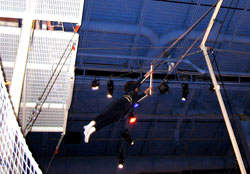
| Vol.
XIX No.
2 November / December 2006 |
| contents |
| Printable Version |
FitFaculty@MIT
Making time for exercise leads to greater camraderie, productivity, "svelteness"
“Challenging,” “competitive,” and “way cool” are some of the adjectives Prof. Dick Larson uses to describe getfit@mit, MIT’s annual fitness challenge. Larson, director of the Center for Engineering Systems Fundamentals and a member of the “Civil Unrest” getfit team for the last two years, credits the 12-week, team-oriented program for helping him form exercise habits that stuck with him after the program’s end. “No one has ever called me svelte,” he admits, “[but] without getfit@mit, this pre-baby-boom faculty member might be quite un-svelte!”
Free tee-shirts, prizes, fun
“The getfit@mit challenge is intended to encourage exercise during a time of year when the cold weather and short days make it more difficult to stay active,” explains Maryanne Kirkbride, MIT’s clinical director for campus life. “We want participants to challenge themselves, but it is not a competition.” The grand prize winner is chosen at random from all teams that meet a minimum average number of minutes for at least 10 of the 12 weeks. Everyone who registers gets a free tee-shirt, and all participants will have opportunities to win weekly team and individual prizes, including gift certificates to sporting goods stores and restaurants and fitness-related prizes such as pedometers, dance lessons, and passes to ski areas and skating rinks.
The third annual challenge, presented by MIT Medical, the MIT Health Plans, and MIT Medical’s Center for Health Promotion and Wellness, begins on January 22, 2007. Registration opens at the end of December and continues through January 17.
Participants will form teams of five to eight members and keep track of their exercise minutes for each week of the challenge.
Individual participants will choose passwords that allow them to log on and enter their weekly exercise minutes at the getfit@mit Website: getfit.mit.edu. Team and individual results will be tracked online, but participants will have to be logged on to view their individual results and those of their teammates identified by name. “The rest of your team will know how much you exercise, but it’s not like everyone at the National Academy of Engineering annual meeting will know that you only managed to eke out 20 minutes during the seventh week of the challenge,” Kirkbride quips.
Team spirit
A team-based challenge might seem a bit of a hard sell in the bastion of individuality that is MIT, but faculty participants say that being part of a team is one of the best aspects of the program. Larson cites the benefits of faculty members having an opportunity “to interact with MIT staff members in a way quite different from normal day-to-day business.” Prof. Merton Flemings, MIT-Lemelson Program director, and "Buff Stuff" team member, says getfit@mit is “a great way to build camaraderie in a research or administrative group.”
Prof. Richard Locke, the Alvin J. Siteman Professor of Entrepreneurship and Political Science, agrees. “My team consisted of both faculty and staff at Sloan,” he explains. “Although we knew each other professionally before, our sense of camaraderie grew because of our collaboration on the getfit challenge. It’s a really fun thing to do!” Locke’s Sloan colleagues, Prof. Deborah Ancona and Prof. John VanMaanen, add that the encouragement of teammates and the need to report one’s exercise minutes each week serve as real motivators to keep going. “At the 300-minute mark [at the end of the challenge], it pushed me to hit the numbers and not let down the team,” VanMaanen notes.
Lower cholesterol, higher productivity
Prof. Larry Vale, head of the Department of Urban Studies and Planning, says that joining a getfit team initially felt like “yet another thing I didn’t have time to do.” But now he says, “It became just the excuse I needed to start, and keep up, a regular exercise routine – one that quickly led to weight loss, coupled with clear improvements in cholesterol levels and blood pressure. I feel more energized than ever now. Far from a time sink, the time devoted to exercise has increased the productivity of my day.”

Other getfit@mit participants also cite real and lasting benefits of the program. Of the 70 percent of getfit participants who began exercising more as a result of the 2005 challenge, almost half continued exercising at this increased level throughout the rest of the year. Additionally, about a quarter of participants report losing weight, reducing stress levels, and sleeping better. About 40 percent report improvements in general mood.
Get ready, get set, get fit!
To learn more about the upcoming getfit@mit challenge, visit getfit.mit.edu. Enter your e-mail address to receive a reminder when registration opens. Or get a jump on organizing a team by downloading a team sign-up sheet now. “Some of us need just a bit of encouragement or team spirit to get to the gym,” says Prof. Steven Eppinger, deputy dean of MIT’s Sloan School of Management. “If this is what it takes to get you moving, then getfit@mit is for you!”
| Back to top | |
| Send your comments |
| home this issue archives editorial board contact us faculty website |